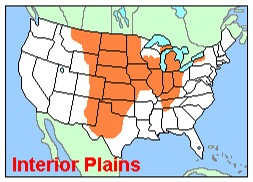Interior Plains
|
|
The Interior Plains is a vast region that spreads across the stable core (craton) of North America. This area had formed when several small continents collided and welded together more than a billion years ago, during the Precambrian. The Great Plains region of the United States falls within this area.
Precambrian metamorphic and igneous rocks now form the basement of the Interior Plains and make up the stable nucleus of North America. With the exception of the Black Hills of South Dakota, the entire region has low relief, reflecting more than 500 million years of relative tectonic stability.
| Contents |
Palaeozoic and Mesozoic
Throughout the Palaeozoic and Mesozoic eras the mostly low-lying Interior Plains region remained relatively unaffected by the mountain-building tectonic collisions suffered by the western and eastern margins of the continent. During much of the Mesozoic Era, the North American continental interior was mostly well above sea level, with two notable exceptions. During part of the Jurassic (208-144 million years ago), rising seas flooded the low-lying areas of the continent. Much of the Interior Plains eventually lay submerged beneath shallow Sundance sea.
Cretaceous Period
Once again, during the Cretaceous Period (144-65 million years ago), record high sea levels flooded the continental interior with shallow seas.
Cenozoic
The Interior Plains continued to receive deposits from the eroding Rocky Mountains to the west and Appalachian and Ozark/Ouachita Mountains to the east and south throughout the most recent era, the Cenozoic. The flatness of the Interior Plains is a reflection of the platform of mostly flat-lying marine and stream deposits laid down in the Mesozoic and Cenozoic eras.
External link
- USGA desciption of the U.S. Interior Plains region (http://vulcan.wr.usgs.gov/LivingWith/VolcanicPast/Notes/interior_plains_region.html)

